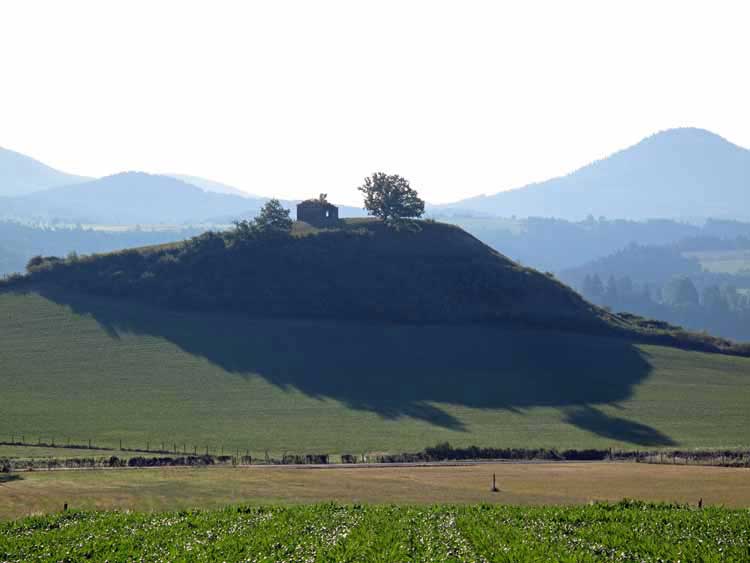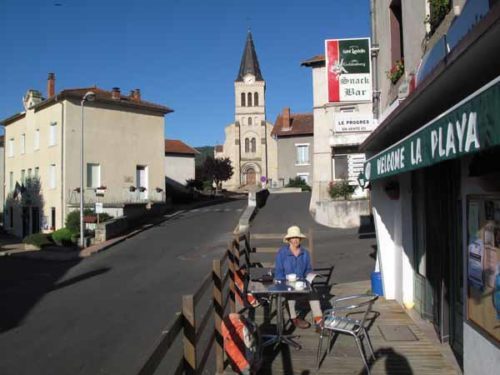
Sunday, 3 July 2011
Distance 21 km
Duration 4 hours 30 minutes
Ascent 225 m, descent 140 m
Map 149 of the TOP100 lime-green series
Map 156 of the TOP100 lime-green series
Topoguide (ref. 4304) Gorges de la Loire sauvage
When we regained consciousness at 6 o’clock, a deathly hush pervaded the camping ground.
We packed up quickly, shivering in the dawn chill, and crept over to have our breakfast outside the closed office, where there was a table and chairs.

In the village square, the silence was broken only by a few stallholders setting themselves up for the Sunday market.
We went into the boulangerie for a baguette and felt like staying there, it was so warm and fragrant inside, but we knew we would be sorry later if we did, as we had a long way to go and the forecast was for a hot day. Anyway, they were not offering coffee.
For the first part of the walk we made our own route, much shorter than the GR and no less quiet.

Just around the corner from the square, we left the highway and took a small ascending road (the D28) out of the village, and then an even smaller one up to the tiny settlement of Brigols.
The countryside was open pastureland, with the mountains of the Cévennes ahead of us, drawing closer as we went along.
Reconnecting with the D28, we soon found the GR and followed it for a kilometre or so along a dirt road into Chalignac, a pretty little place hidden in trees.

Then we diverged again, or rather the GR did, while we pressed on for another kilometre, up and over to the nearby village of Saint-Vincent, arriving just as the church bells rang out for 8 o’clock.
Saint-Vincent looked at least as sleepy as Chalignac, but to our amazement there was a snack bar on the corner (la Playa), with the coffee machine just growling into life inside. We dragged a table and chairs out onto the wooden terrace and ordered coffee.

Madame was mortified that she could not offer us croissants as well, but we did not mind, it was the caffeine shot that we were after.
With her help, we picked the right road out of the village, an old dirt track shaded by huge trees, which descended gradually towards the Loire and was soon joined by the GR.

Half an hour later we crossed the railway line, the road and the river in quick succession and found ourselves in Lavoûte-sur-Loire.
Being on the main highway up the gorge, this was a much bigger place, with several shops and two bars, face to face.

We chose the one on the sunny side (le P’tit Goret) and, after laying in supplies at the nearby shop (croissants, nectarines, cheese and a tomato), we settled down for our second breakfast.
Whilst enjoying this refreshment, scattering pastry crumbs all over the table, we consulted the Topoguide and the map, trying to decide what to do next.
The GR took a steep, zigzag route up to the western escarpment and stayed high all the way to le Puy, whereas the road climbed steadily beside the river.
The former was obviously the more interesting way, but in view of my recent weakness we decided on the latter. It would get us to our destination with the least amount of effort.

While it could never be recommended as an ideal stroll, it was surprisingly pleasant walking on the side of the highway, with the Loire below us on the right and the railway line darting in and out of tunnels and across bridges.
Just after we left Lavoûte, we passed the picturesque château of Lavoûte-Polignac with its pepper-pot towers, encircled on three sides by a loop of the river.
The gorge was wild and beautiful and it was easy to imagine it in its original state, before the road and railway made it accessible.

Further up, the river became friskier as the gorge narrowed and its heavily wooded sides leaned in.
We, on the other hand, got less and less frisky and by the time we got to the broad uplands close to Chadrac, I at least was getting very tired. The day was now hot and the last few kilometres through the outskirts of le Puy were hard to bear.
We trudged on through the streets until we found a pathway beside the river Borne, signposted as a GR, which was shady and quiet, leading us past carefully tended vegetable allotments, lawns and playgrounds.

Having been to le Puy before, we knew we were close to our destination when we passed the two absurd spikes of rock (known as puys) that define the town – one topped by an ancient chapel and the other by a monstrous red statue of the Virgin, made from melted-down Napoleonic cannons.
We got to the camping ground, on the banks of same river, as the bells of midday pealed joyfully, celebrating our achievement of a complete circle around France. As this was the tenth year of our long walks in France, it was about time that we joined the circle.

Having paid at the entrance, we set up our tent in the section of the grounds reserved for walkers and cyclists, of whom there were many. At all our previous camping grounds we had been the only campers without a car, but le Puy was the start of the most popular pilgrim route in France and things were very different here.
Nevertheless there were no other English speakers, which was surprising. Most were French and nearly all of them were just starting out on their adventure in the morning. We felt comparatively tough and fit after our two weeks on foot, despite our post-‘flu weakness.
Hot showers and a picnic in the shade were followed by a period of horizontality on our mattresses. Although the sunshine was scorching, it was cold in the deep shade of the trees, so we dodged between the two.

As the sun declined we rose and set off towards to the town, taking the steep, direct way up to the cathedral. Here we found ourselves at the head of the great staircase, lined with gift shops, that led down to the lanes of the old town.
There were plenty of restaurants in these lanes, offering meals of uniformly bad value – for example a plate of lentils with one sausage for €14. Although lentils are the speciality of le Puy (“lentilles du Puy” is a controlled appelation), we were not tempted.
Lower down, the main thoroughfare (the Boulevard St-Louis) had slightly more of a local feel, and we found a nice expansive bar on the corner of the Rue Vibert called the Café Aviation, where we were among people who looked as though they lived in the town.

We had a drink under one of the many awnings on the pavement, then wandered along the street to the same brasserie that we had dined at on both our previous visits to le Puy – le Palais. This shows how little choice there was for such a big town.
I had a three-course meal for €12.90, while Keith had an entrecôte for the same money, but we shared the first and last courses.
For the sake of regional variety, we started with a dish of lentils in mayonnaise, which was of monumental proportions and looked strange, but was delicious. I had duck à l’orange next, and we finished with two scoops of icecream (coffee and vanilla).
It was almost dark when we arrived back at our little home, which by then had been joined by even more little tents like ours, making a veritable village of pilgrims.
Leaving le Puy-en-Velay
Le Puy has a railway station. From there you can go to almost anywhere in France.